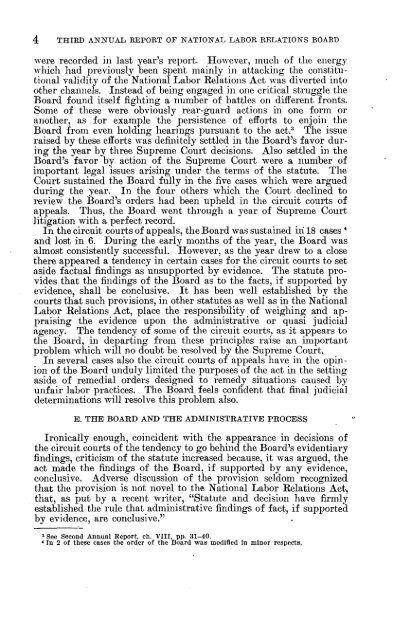NATIONAL LABOR RELATIONS BOARD
NATIONAL LABOR RELATIONS BOARD
NATIONAL LABOR RELATIONS BOARD
Create successful ePaper yourself
Turn your PDF publications into a flip-book with our unique Google optimized e-Paper software.
4 THIRD ANNUAL REPORT OF <strong>NATIONAL</strong> <strong>LABOR</strong> <strong>RELATIONS</strong> <strong>BOARD</strong><br />
were recorded in last year's report. However, much of the energy<br />
which had previously been spent mainly in attacking the constitutional<br />
validity of the National Labor Relations Act was diverted into<br />
other channels. Instead of being engaged in one critical struggle the<br />
Board found itself fighting a number of battles on different fronts.<br />
Some of these were obviously rear-guard actions in one form or<br />
another, as for example the persistence of efforts to enjoin the<br />
Board from even holding hearings pursuant to the act. 3 The issue<br />
raised by these efforts was definitely settled in the Board's favor during<br />
the year by three Supreme Court decisions. Also settled in the<br />
Board's favor by action of the Supreme Court were a number of<br />
important legal issues arising under the terms of the statute. The<br />
Court sustained the Board fully in the five cases which were argued<br />
during the year. In the four others which the Court declined to<br />
review the Board's orders had been upheld in the circuit courts of<br />
appeals. Thus, the Board went through a year of Supreme Court<br />
litigation with a perfect record.<br />
In the circuit courts of appeals, the Board was sustained in 18 cases<br />
and lost in 6. During the early months of the year, the Board was<br />
almost consistently successful. However, as the year drew to a close<br />
there appeared a tendency in certain cases for the circuit courts to set<br />
aside factual findings as unsupported by evidence. The statute provides<br />
that the findings of the Board as to the facts, if supported by<br />
evidence, shall be conclusive. It has been well established by the<br />
courts that such provisions, in other statutes as well as in the National<br />
Labor Relations Act, place the responsibility of weighing and appraising<br />
the evidence upon the administrative or quasi judicial<br />
agency. The tendency of some of the circuit courts, as it appears to<br />
the Board, in departing from these principles raise an important<br />
problem which will no doubt be resolved by the Supreme Court.<br />
In several cases also the circuit courts of appeals have in the opinion<br />
of the Board unduly limited the purposes of the act in the setting<br />
aside of remedial orders designed to remedy situations caused by<br />
unfair labor practices. The Board feels confident that final judicial<br />
determinations will resolve this problem also.<br />
E. THE <strong>BOARD</strong> AND THE ADMINISTRATIVE PROCESS<br />
Ironically enough, coincident with the appearance in decisions of<br />
the circuit courts of the tendency to go behind the Board's evidentiary<br />
findings criticism of the statute increased because, it was argued, the<br />
act made the findings of the Board, if supported by any evidence,<br />
conclusive. Adverse discussion of the provision seldom recognized<br />
that the provision is not novel to the National Labor Relations Act,<br />
that, as put by a recent writer, "Statute and decision have firmly<br />
established the rule that administrative findings of fact, if supported<br />
by evidence, are conclusive."<br />
3 See Second Annual Report, ch. VIII, pp. 31-40.<br />
In 2 of these cases the order of the Board was modified in minor respects.

















